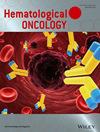Risk Stratification for Diffuse Large B-Cell Lymphoma by Integrating Interim 18F-FDG PET-CT Analysis and the NCCN-IPI: A Multicenter Retrospective Study
Abstract
Our study aimed to assess the prognostic significance of the interim National Comprehensive Cancer Network International Prognostic Index and PET-CT-related parameters for predicting patient outcomes and achieving precise risk stratification for diffuse large B-cell lymphoma (DLBCL) patients. We retrospectively analyzed the clinicopathological and PET-CT data of 498 patients diagnosed with DLBCL across three medical centers in China. 418 patients were eligible for subsequent analysis after excluding those with incomplete data and 70% of which were randomly selected as the discovery cohort, whereas the remaining 30% constituted the validation cohort. The impact of candidate factors on survival was assessed via univariate and multivariate Cox proportional hazards models. The area under the curve AUC and C-index were calculated to assess the predictive performance of models. Univariate and multivariate Cox regression analyses identified changes in total lesion glycolysis (ΔTLG), iNCCN-IPI, interim abdominal residual disease (iARD) status, and changes in the maximum standardized uptake value (ΔSUVmax) as independent prognostic factors. Leveraging the outcomes of the multivariate analysis, we constructed the iPET-NCCN-IPI prognostic model and categorized DLBCL patients into two separate prognostic risk groups based on their computed Risk Scores (RS = 0.90×iNCCN-IPI + 1.41×ΔTLG + 0.79×ΔSUVmax + 0.83×iARD). The predictive performance of the model was validated by calculating the area under the receiver operating characteristic curve and the C-index. Notably, compared with other models, the iPET-NCCN-IPI demonstrated superior prognostic capability. In conclusion, our study indicates that the iPET-NCCN-IPI stratifies DLBCL patients into two distinct prognostic risk groups and surpasses other models in prognostic predictive ability.

 求助内容:
求助内容: 应助结果提醒方式:
应助结果提醒方式:


